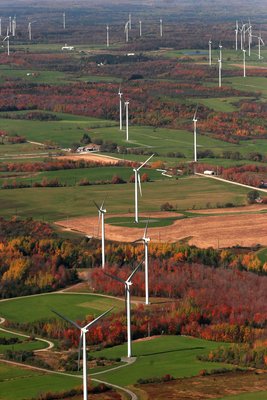
Wind
Wind Energy Resources
Wind is a variable energy-generating source, with strong diurnal, seasonal, inter-annual, and geographic patterns. Figure 1 depicts the general distribution of annual average land-based and offshore wind speeds at a height of 80 meters (m).
Regional wind climates in the United States are caused by the interplay of jet-stream-induced storm tracks, meteorological factors that occur closer to the ground surface, and features of the regional and local terrain. In the Eastern Interconnection, land-based wind resources are present in the mountainous areas in the east, and less intense but more consistent wind resources are present in the central Great Plains. Wind resources are less abundant in the southeast, but some suitable areas may be found along the coast or on elevated features.
The deployment of wind turbines has increased significantly, and the market for wind power has been the fastest-growing renewable energy technology market in the United States for the past decade. The Energy Information Administration reported that there was almost 40 GW of installed wind capacity in 2010 (EIA 2011); Wind Powering America and the American Wind Energy Association reported that an additional 7 GW of wind power capacity was installed in 2011 (WPA 2012). Almost half of the total U.S. wind power capacity is installed in the Eastern Interconnection, and more than half of the Eastern Interconnection’s installed wind capacity is in the Midwest ISO (MISO) or Southwest Power Pool (SPP) control areas. To date, all of the installed capacity in the United States is land-based, but several offshore wind farms have been proposed.

Wind Energy Technology
Wind turbines use the kinetic energy in the wind to turn a large rotor and then convert that rotational energy to electricity. Land-based wind resource data is available at 80-m and 100-m height above ground. These heights are the typical hub height of current wind turbine technology being installed in the United States and has been steady for the past several years (Wiser and Bolinger 2011). The most common type of technology is the horizontal-axis wind turbine (Figure 2), which uses a tall tower with airfoil blades coupled to a generator located in the nacelle (enclosure). The typical power capacity is 1.5 to 2.5 megawatts per turbine. There can be variations in this design (e.g., number of blades [two or three], size of blade, passive versus active yaw systems). The rotor at the top of the tower can face into or away from the wind.
Offshore wind turbines use the same horizontal-axis wind turbine structure but need to be anchored or supported to operate stably at a fixed location. The majority of offshore wind installations in the world have been in relatively shallow water (depths of 30 m or less), where the turbines can be anchored directly into the seabed. The deployment of wind turbines in deeper water, through the use of floating platforms or other methods, is still in the early stages of development (Musial and Ram 2010).
Parameters in addition to wind speed and wind power density that affect the performance of a wind farm include the prevailing wind direction, frequency distributions of wind speed and direction, and wind shear (change of wind speed with height). Wind speeds are typically given in meters per second (m/s), and wind power density values are in watts per square meter (W/m2).

(Note: The wind farm contains 195 horizontal-axis, 1.65-MW wind turbines) (Source: NREL 2013)
References
EIA (Energy Information Administration), 2011, Electric Power Annual 2010 Data Tables. U.S. Department of Energy. http://www.eia.gov/electricity/annual/html/table1.2.cfm. Accessed July 19, 2012.
Musial, W., and B. Ram, 2010, Large-Scale Offshore Wind Power in the United States: Assessment of Opportunities and Barriers. National Renewable Energy Laboratory Report TP 500-40745.
NREL (National Renewable Energy Laboratory), 2013, Photographic Information eXchange, Photo #15236, http://images.nrel.gov/. Accessed March 2013.
WPA (Wind Powering America), 2011, Onshore Wind Resource Potential, U.S. Department of Energy, Office of Energy Efficiency & Renewable Energy. http://www.windpoweringamerica.gov/windmaps/resource_potential.asp. Accessed July 20, 2012.
Wiser, R., and M. Bolinger, 2011, 2010 Wind Technologies Market Report. Lawrence Berkeley National Laboratory Report LBNL-4820E.

